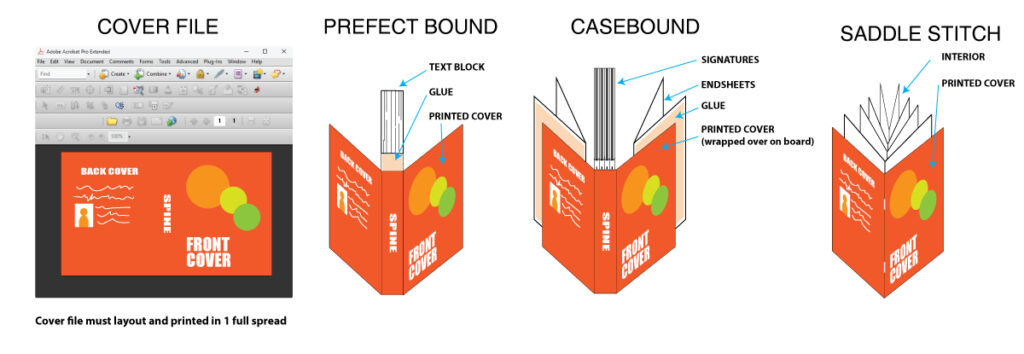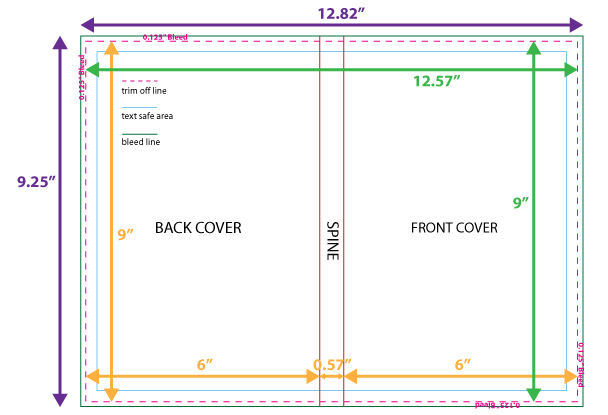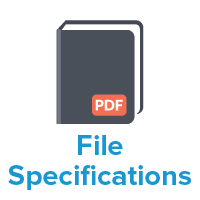Getting the technical details right is crucial, especially when it comes to cover spreads. Let’s delve into the technical perspective to set up for a smoother printing process and a superior final product.
The two major components to make a book are the “Cover”, and the “Text-block” (often referred to the ‘gut’ or ‘interior’). Many people see the book cover by panels: font cover, spine, and back cover, which is correct in the reading prescriptive; but when it comes to preparing the file for book publishing, we need to fall back a few steps and understand how the book cover bind with the text-blocks (will also refer as interior file in this blog).
The Reason to Have a Cover Spread in Separate File
The material uses and finishing of the cover a text-block are different – normally used cardstock or greyboard for cover and paper for the text-block; other than the material and finishing difference, the dimensions of the file are different as well. Therefore, we should have two print ready files: the cover file and the interior file, to servers the different components of the book. A print ready cover file must be in full spread that includes the back cover, spine, and front cover from left to right (or reverse the order if you are doing a book with spine on right); the three panel will print in one large sheet of cover stock and wrap around the printed text-block to form a “book”.

Pagination of the Text-block (interior file)
The first page of the interior file will always fall on the right-side of the book. With the fact that a piece of paper comes with two sides and the first page on the right rule, odd pages will always fall on the right hand side while the even pages always fall on the left hand side following the traditional reading conventions.

Dimensions for Different Book Binding
Different binding types necessitate distinct cover spread setups. In the case of perfect bound books and board books, the cover height must correspond to the desired book height, while the width should encompass the front cover width, spine width, and back cover width (layout front cover + spine + back cover in one file). If you need to find out the spine width, utilize our spine width calculator to simplify this process.
Hardcovers are equipped with custom templates to ensure accuracy. Contact us for hardcover template. Conversely, saddle stitch and thread stitch books, due to their binding method, do not require a spine. Similarly, wire-o and coil-bound books follow a different protocol as they don’t utilize a traditional cover spread setup.
Below is a cover spread formula chart for you to follow along with
| Binding Type | Width Calculation | Height Calculation |
|---|---|---|
| Perfect Bound Books and Board Books | 0.125″ Bleed + Book Width + Spine Width + Book Width + 0.125″ Bleed | 0.125″ Bleed + Book Height + 0.125″ Bleed |
| Saddle Stitch/Thread Stitch | 0.25″ Bleed + Book Width + Book Width + 0.25″ Bleed | 0.25″ Bleed + Book Height + 0.25″ Bleed |
| Wire-O/Coil Bound Books | 0.125″ Bleed + Book Width + 0.125″ Bleed | 0.125″ Bleed + Book Height + 0.125″ Bleed |
| Casebound | Ask us for template | Ask us for template |
Calculating the cover file dimensions
After having the interior file ready with the exact page count, then you can calculate the spine width precisely and create the cover file. By key in the specification of you book (cover type, inside stock, and page count) to our spine width calculator, you’ve now got all the information needed to calculate the cover file dimensions by following the formula below.
Example of Cover Spreads Dimensions
Lets look into a step-by-step guide into explaining how we can use these formulas to create a cover spread.
Step 1: Determine Book Specifications
Let’s say we want have a book that is: Perfect bound book, 6″w x 9″h inches, with 300 pages printed on 50lb uncoated stock.
Step 2: Calculate Spine Width
Using our spine width calculator found here we can see that the spine width is 0.57 inches.

Step 3: Calculate Cover Spread Dimensions
Referencing the chart, determine the width and height calculations based on the binding type. For the perfect bound book with a 6×9 inch size.
Width formula: Width=0.125″+6″+0.57″+6″+0.125″
Height formula: Height=0.125″+9″+0.125″
Step 4: Finalize Dimensions
Now that the calculations are complete, the cover spread dimensions for the perfect bound book with a 6×9 inch size should be 12.82 inches in width and 9.25 inches in height.

Where to create the cover spreads?
Authors and publishers have several options for creating cover spreads. Many software programs, such as Adobe InDesign, Photoshop, and Canva.com, offer tools for designing cover spreads. Alternatively, our in-house graphic designers can create a custom cover spread tailored to your specifications.
By adhering to technical guidelines for file creation, such as bleed, trim, resolution, and color management, authors and publishers ensure seamless compatibility with printing equipment and software. This results in fewer complications and superior outcomes for all parties involved.
In summary, while cover spreads may seem like a minor detail, they play a critical role in ensuring that printed books meet high standards of quality and appearance. Therefore, when preparing files for printing, it’s essential to consider the technical aspects of cover spreads to achieve optimal results.







